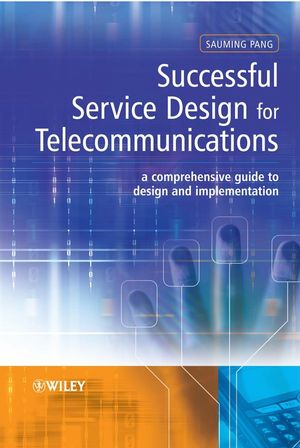Successful Service Design for Telecommunications: A comprehensive guide to design and implementationISBN: 978-0-470-75393-4
Hardcover
360 pages
March 2009
 |
||||||
1.1 Who is this book for?.
1.2 Structure of the book and who should read which chapter
1.3 Definitions.
Chapter 2. What is Service Design?.
2.1 What is a service?.
2.2 What is the difference between a service and a product?.
2.3 Service vs. network capabilities.
2.4 What are the difference between a service and an application?.
2.5 Intra-domain vs. Inter-domain services.
2.6 What is Service Design and what is the role of a Service Designer?.
Chapter 3. Service – a Business Perspective.
3.1 Pre-conditions for service design.
3.2 Business requirements.
3.3 Market or marketing requirements.
3.4 Reporting requirements.
3.5 Security requirements.
3.6 Functional requirements.
3.7 Network planning requirements.
3.8 Non-functional requirements.
3.9 Regulatory, licensing and legislation considerations.
3.10 Financial constraints.
3.11 Physical location and space of network equipment and systems.
3.12 Service description template - a service description that fully defines the service
3.13 The success criteria for a service.
Chapter 4. Service Design Process.
4.1 What are they key steps to develop new services and service enhancements?.
4.2 How should the process link to business approvals at various Phases of the development?
4.3 Organizational changes and structure required to develop new services.
4.4 Resource requirement for designing services.
4.5 How you can use the service development process for one off customer requests?
4.6 Programme management structure.
4.7 Documentation and control structure for Service Design.
Chapter 5. Service Design – What needs to be done. .
5.1 Performing rapid impact analysis.
5.2 Performing feasibilities studies.
5.3 Design and develop.
5.4 Implementation and test
5.5 Service launch and operate.
5.6 Service withdrawal
Chapter 6. Service Building Blocks.
6.1 The Building Blocks.
6.2 Conceptual network architecture for fixed and 3G mobile services.
6.3 Interactions between the network and the support systems.
6.4 System functions required for all services.
6.5 Operational support processes for all services.
6.7 Summary.
Chapter 7. Network Design and Development
7.1 Network requirements.
7.2 Technical network considerations.
7.3 Service network design.
7.4 Network security.
7.5 Network Inventory.
7.6 Capacity planning, network planning and optimisation.
7.7 Service configuration in network elements.
Chapter 8. System Functions and Development
Systems requirements and methodology.
8.1 Inter-relationships between the functional areas in the systems domain.
8.2 Customer creation, order management and service termination.
8.3 Customer network provisioning and network termination.
8.4 Customer service provisioning (including moving, additions and changes)
8.5 End users creation and order management
8.6 End user network provisioning.
8.7 End users’ service provisioning, service control (esp. in QoS based services) and service termination
8.8 Billing, charging and rating.
8.9 Service accounting, revenue reporting, OLO bill reconciliation and revenue assurance
8.10 Fault management
8.11 Network management (monitoring and collecting events from the network) and service management
8.12 Performance management
8.13 Capacity management, traffic management and network planning.
8.14 Reporting.
8.15 System support and management
Chapter 9. Operational Support Processes.
9.1 Sales engagement processes.
9.2 Customer service processes.
9.3 Service and network provisioning.
9.4 Service management processes.
9.5 Network management and maintenance processes.
9.6 Network traffic management, network capacity management and network planning processes
9.7 System support and maintenance process.
9.8 Revenue assurance processes.
9.9 Process mappings to eTOM model
Chapter 10. Implementation Strategy.
10.1 What is implementation?.
10.2 What is implementation strategy?.
10.3 Why do we need an implementation strategy?.
10.4 What are the steps and approach to take when defining an implementation strategy?
10.5 Implementation strategy example.
Chapter 11. Service Integration and Service Launch.
11.1 Service Integration Model
11.2 Service Integration Strategy.
11.3 Test Environment vs Live Service Environment
11.4 Post Service Launch Reviews.
Chapter 12. Service Withdrawal, Migration and Termination.
12.1 Service Withdrawal
12.2 Service Migration.
12.3 Service Termination.
13 Glossary.
14 References.
15 Index.



